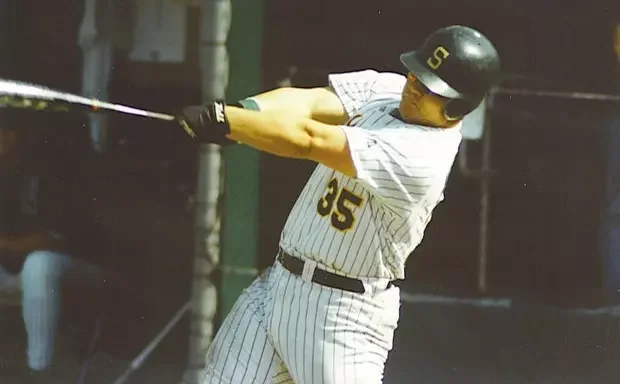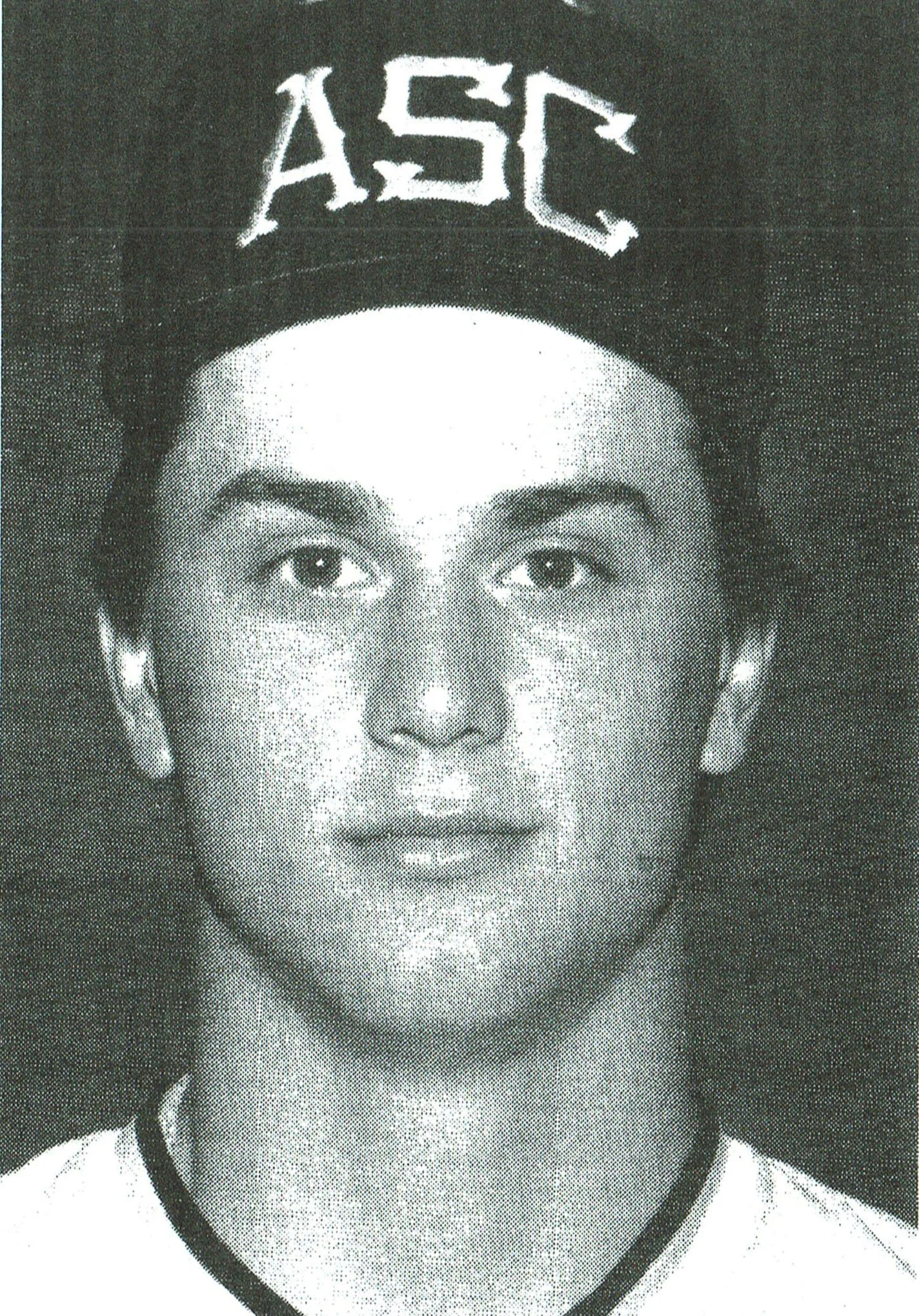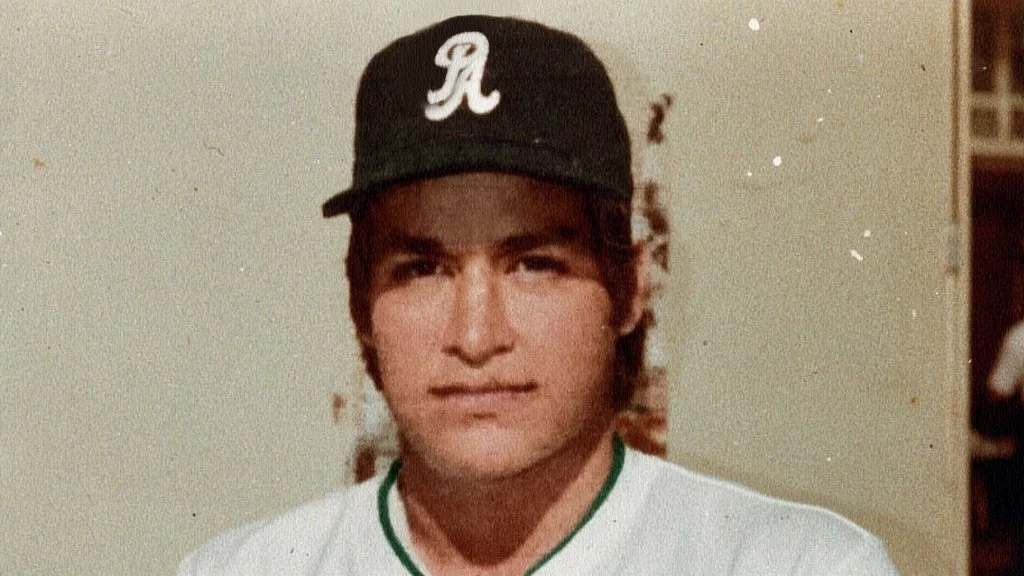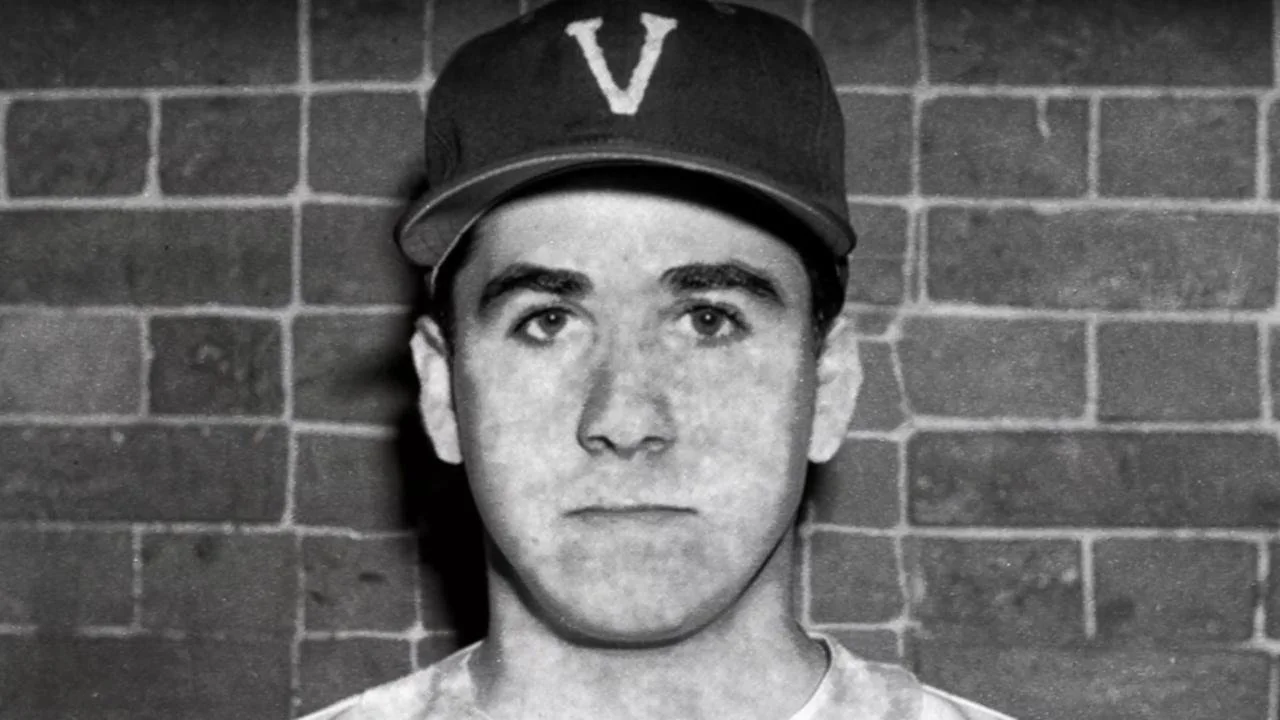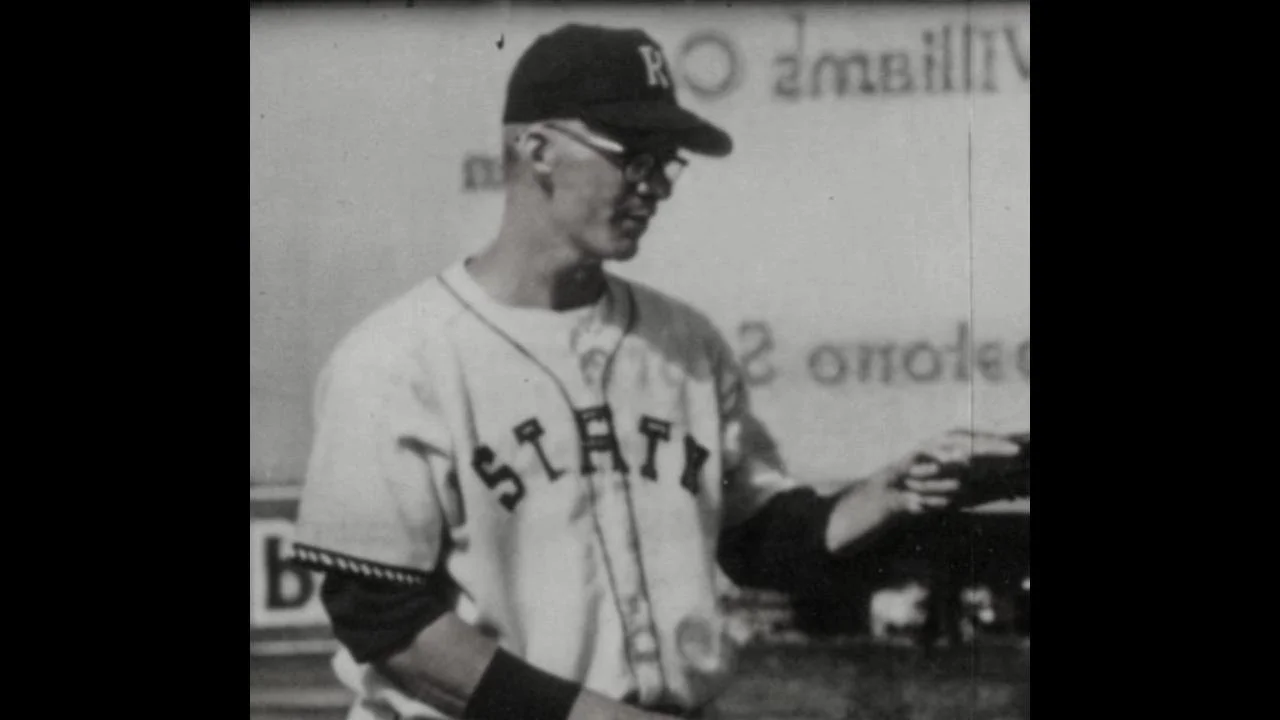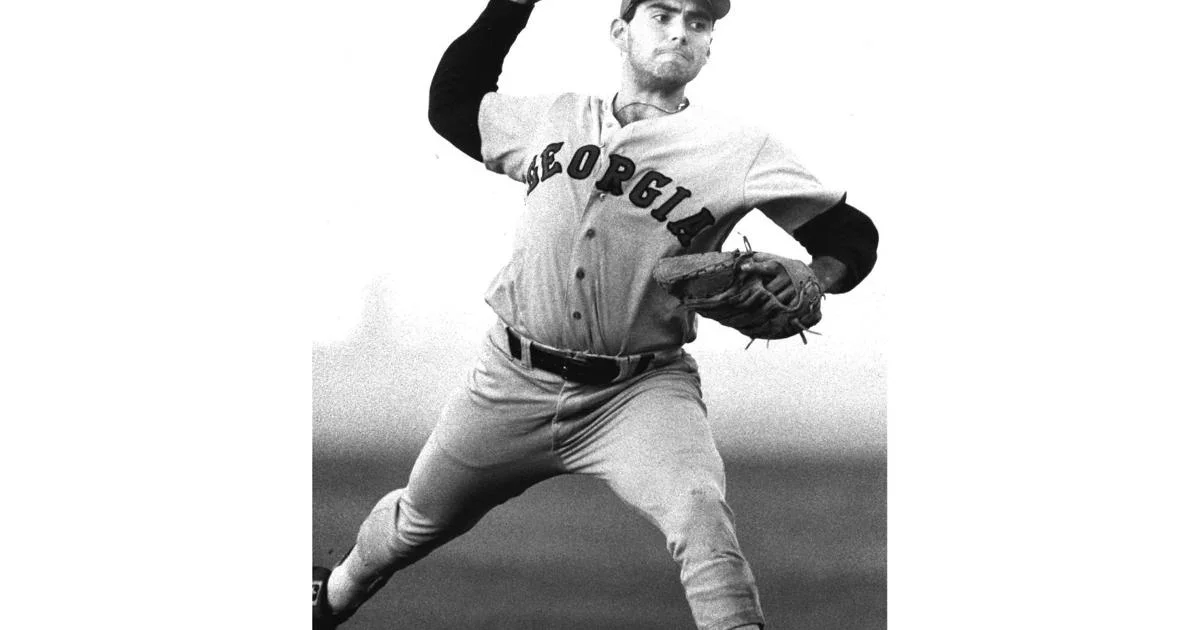15. Butch Edge – RHP (1974 - 6th Overall – Milwaukee Brewers)
With a name like Butch Edge, this guy was destined to make it to the big leagues, and he eventually did. But long before that, he was a hot High School prospect who made the Face in the Crowd section of a June, 1974 Sports Illustrated issue that read “Butch Edge, a senior at El Camino High, Sacramento, was involved in all 21 outs in his team's victory in a city playoff game, recording 19 strikeouts and fielding two grounders for outs.” He was a strikeout machine with an incredible arm and the Brewers drafted him 6th overall in 1974. Unfortunately, his numbers in the minors were average at best, although he did make it to Triple-A in 1978, going 2-10 with a 5.3 ERA. The Jays moved him to the bullpen, where he showed improvement and got an MLB call up in 1979, as a starter again. He went 3-4 with a 5.57 ERA and just 19 strikeouts in 51 innings. The Blue Jays released him and he played a bit in the minor league systems of the Braves and Pirates before hanging them up permanently.
14. John Bohnet - LHP (1979 - 7th Overall – Cleveland Indians)
Bohnet pitched at Hogan High School in Vallejo, California and was practically untouchable with a 93 MPH fastball. In April of 1979, with the draft coming up, he threw a no-hitter in front of several scouts, striking out 12 batters. His Junior year, he struck out 116 batters with just 23 walks and a 1.16 ERA, setting several school records. He made clear his plan to sign with a pro team if he was drafted high. In 1979, he was taken 7th overall by the Indians, and jumped right into Low A, going 6-3 with a 2.9 ERA and 9.9 per 9 strikeout ratio. He continued to pitch well in the minors, climbing the ladder to Triple-A, where he was 1-1 with a 2.2 ERA in 4 games when the Indians called him up. He started just 3 games, giving up 9 runs in 11.2 innings with 7 walks and just 4 strikeouts. After a major elbow injury, he was sent back to the minors to rehab later that year. He struggled in Double-A for the next two years, never finding his old form, and was released in April of 1984.
13. Rick O'Keeffe - LHP (1975 – 5th Overall – Milwaukee Brewers)
Towering southpaw Rick O’Keeffe was a strikeout machine in High School, leading his conference with 82 strikeouts. In 1974, he went 6-1 with a .4 ERA. The Brewers took him first overall and assigned him to Low A Newark, where he went 7-3 with a 2.83 ERA, but he did walk 54 batters in 67 innings. He improved that walk rate in 1975, going 7-4 with a 2.87 ERA in A Ball, striking out 113 batters while walking 95 in 166 innings. The Brewers were pleased enough to invite him to big league Spring Training in 1976. But that year, at the trade deadline, they sent him to Cincinnati along with fellow minor league Garry Pyka for big league pitcher Mike Caldwell, who went on to finish 2nd for the Cy Young in 1978 for Milwaukee with a 22-9 record, and he helped them reach the World Series in 1982. As for O’Keefe, he pitched in the minors for the next 4 seasons in the Reds organization, never getting the call-up, despite some strong seasons. He had a shot to make the team out of Spring Training in 1982, but ended up in Triple-A, then was traded to the Blue Jays. With Triple-A Syracuse, he went 2-3 with 7.64 ERA and just 19 strikeouts in 50 innings. He was released in July. After surgery to remove bone chips in his elbow, he missed all of 1983 and attempted a comeback in 1984 with the Mets organization but after 7 starts with a 4.89 ERA, allowing as many walks as strikeouts, he suffered a groin injury and called it a career.
12. Roy Branch – RHP (1971 - 5th Overall – Kansas City Royals)
In 1971, the Kansas City Royals took Roy Branch fifth overall out of Beaumont High School in St. Louis, Missouri. His Senior Year, he went 7-0 with a .6 ERA and 96 strikeouts using a hard fastball and sharp curveball, but he was a bit wild and needed to work on his control in the minors. Branch was also the star quarterback, but he preferred baseball and when he got drafted 5th overall, it was an easy decision to sign with the Royals. Bone chips in his pitching arm held him to just 3 starts in rookie ball. In 1972, his first full season in the minors, Branch walked 80 batters in 120 innings, yet still went 10-5 with a 4.28 ERA. The next season with the San Jose Bees A Ball team, a hernia kept him out for half the season, and when he did pitch, his control got even worse as he walked 68 in 69, nearly a batter per inning. The Royals coaches continued to work with him, eventually moving him up to Double-A. In 1976, his 6th year in the minors, he started 23 games, with a 3.1 ERA and 4.2 walks per 9, still high but an improvement. He was still in double-A in 1977 and said “If I hadn’t been a bonus baby, I probably would’ve been gone by now.” He had a solid season that year between Double-A and A Ball, going 9-13 with a 2.75 ERA, but his control was still an issue and the Royals released him. He ended up in the Mexican League, and showed enough for the Mariners to sign him to a late season deal. They brought him back in 1979 for some extra depth and despite a below average season in Triple-A, the M’s brought him up when rosters expanded and he made 2 big league starts, going 0-1 with an 8.44 ERA. He spent all of 1980 in Triple-A continued to play in the Mexican League and in various independent leagues throughout the 80’s and also played in the Pacific Senior League from 1989 to 1991. He may have been a bust, but at least Roy Branch did make it to the big leagues after an extremely long road in the minors.
11. Tommy Bianco – 3B (1971 - 3rd Overall – Milwaukee Brewers)
In 1971, The Milwaukee Brewers took a switch hitting infielder with massive potential named Tommy Bianco third overall in the draft. In High School, he was a phenom who played in Shea Stadium at 15 years old in a greater New York High School Tournament and he went 15 for 16. He consistently hit well over .450 throughout his High School career and had one of the best throwing arms in his draft class. The Brewers held a Press Conference with owner Bud Selig present to announce his signing. Bianco took some time to adjust to playing every day and hitting under the lights, with a .230 average and 11 home runs in Double-A in 1972. However, he broke out in 1974 with Triple-A Sacramento, hitting .281 with 28 home runs and 81 RBIs. After another hot start in 1975, he got the call-up. In 34 at bats he had just 6 hits, a .176 batting average, with no home runs or RBIs. In 1976, he was hitting .268 with 10 homers when Triple-A manager Frank Howard announced Bianco wouldn’t start another game the rest of the season due to lack of hustle. Bianco was released during 1977 Spring Training and signed with the Tigers, but was released after 20 games in Double-A. He played some for the Expos and Orioles organizations as well, but never got back to the big leagues, playing his last season in Triple-A in 1979, hitting just .219 with 2 home runs.
10. Tito Nanni – OF/1B (1978 - 6th Overall – Seattle Mariners)
At Chestnut Hill Academy in Philadelphia, 17-year old Tito Nanni was the captain and MVP of the baseball, football and basketball teams. He was fantastic in all three, and he planned to play college football at North Carolina, but his brightest future appeared to be in baseball as he was an All American and Philadelphia Daily News Player of the Year. His High school Baseball coach, Stan Parker, said “He is the finest High School Baseball Player I’ve seen in terms of all-around pure talent – speed, arm, all of that.” The 6’4”, 205 lb slugger was hitting .528 with just one strikeout his Senior Year as the draft was approaching. The M’s took him 6th overall, but there was some controversy with the contract as the Mariners scouting director offered a $100,000 bonus, a figure much higher than the Mariners had authorized. The bonus had to be re-negotiated and Nanni did not play pro baseball until 1979 with the Class A Alexandria Mariners. He hit just .226 with 6 homers and led the league with 132 strikeouts. Hard times continued in 1980 as he hit .199 with High A San Jose. Then, he started to show improvement after a demotion back to A Ball. “The biggest problem was striking out,” said Nanni, “I’ve got such a long swing. If I was going to hit for average, I had to cut down on my swing.” In 1982 in Double-A, he hit .293 with 16 home runs and an .839 OPS. He still struck out 113 times, but that was a slight improvement. He came back down to Earth a bit in Triple-A over the next two years, still hitting okay but not well enough for a call-up. In 1985, he was hitting .273 with just 6 homers in 466 at bats when the Mariners released him. “They had told me I had the tools, but I was a head case,” he said. “They’d given up on me. That’s the bottom line.” He finished the season with the Blue Jays Triple-A team, then signed with the Angels in 1986, and he played his final pro season with the Midland Angels, hitting .263 with 4 home runs.
9. Tim Cole – LHP (1977 - 4th Overall – Atlanta Braves)
Lefty Tim Cole had set all types of High School records at Saugerties High in New York when he was taken 4th overall by the Braves in 1977. He had a .88 ERA and was considered the top High School left-handed pitcher in the country. Unfortunately, he just never quite figured it out in the minor leagues despite spending 12 years in the Braves system. In 1978 in A Ball, he went 5-8 with a 5.6 ERA and just 68 strikeouts in 106 innings with 99 walks. His command was terrible, and when he did throw strikes, he gave up a lot of hits. In 1979 in Double-A, he was 6-11 with a 5.91 ERA. He pitched for Double-A Savannah for 3 seasons and only showed marginal improvement. In 1980, he pitched well in August and was hoping for a promotion to Atlanta but it didn’t happen. He finally made it to Triple-A in 1982, but had a 6.77 ERA with 80 walks in 97 innings. He pitched mostly from the bullpen after that never above Double-A again. The Braves let him go in 1985. Cole caught on with the Astros and White Sox organizations, but retired after the 1986 season after 10 years in the minor leagues. For his minor league career, he walked an average of 7.2 batters per 9 innings and struck out 6.1 per 9 with an ERA of 5.55.
8. Kevin Richards – RHP (1977 - 5th Overall – Detroit Tigers)
In 1977, the Detroit Tigers had the 5th Overall pick and went with a right-handed arm out of Roosevelt High School in Michigan, Kevin Richards. Richards had electric stuff as he struck out 231 batters in 153 innings with a .69 ERA, but another local senior had even better stats - Brad Havens went 10-1 with a .3 ERA and wasn’t taken until the 8th Round. Havens pitched for 8 years in the big leagues. Richards said “I was surprised that I was their no. 1 pick.” He was sent to rookie ball and struck out 46 batters in 43 innings, not bad for his year in the pros. Unfortunately, he would go on to be plagued by arm trouble for the rest of his career and he didn’t appear in a game in 1978. In ‘79, Richards made just 4 starts and 10 relief appearances in Single A, striking out 16 batters in 45 innings. His velocity was already gone. The following year in Double-A, Richards gave up 10 runs in 3 innings and was shipped to the Texas Rangers, where he pitched in Tulsa for the next two seasons before retiring.
7. Glenn Tufts – 1B (1973 - 5th Overall – Cleveland Indians)
In 1973, the Indians went with a High School first baseman named Glenn Tufts as their 5th overall pick. He was an incredible talent and the stands at his high school games in Bridgewater, Massachusetts were crowded with scouts. He was already a local legend his last year in Little League when he smashed 17 home runs. In High School, he hit .565 as a Sophomore on the Varsity Team. He was hitting .571 his Senior Year when it was time for the MLB Draft. Of course, that batting average was not going to drop significantly in the pros, but it dropped more than any one expected after he hit just .194 in Rookie Ball with a single homer in 155 at bats. Then, in November, he was involved in a car accident in which he broke his pelvis, four ribs and an ankle, forcing him to miss the entire 1974 season. He made a strong comeback in 1975, hitting .270 with 9 home runs in Single A San Jose. He continued to hit well there in 1976, but struggled in Double-A, going 3 for 26 with no extra base hits and also had injury issues with torn cartilage in his left knee. In 1977, he got more time in Double-A to prove himself, but things went south as hit just .163 with zero home runs. He was released at just 22 years old. Tufts noted, "It was time to move on... In reality, it had been over for awhile". He successfully transitioned into coaching and scouting with the San Francisco Giants, remaining in baseball ever since his playing career ended.
6. Les Filkins – OF (1975 - 3rd Overall – Detroit Tigers)
The 3rd overall pick in 1975, Les Filkins, felt like a can’t miss prospect. He was a good student, amazing athlete, and incredible 5-tool ballplayer, and the consensus among scouts was that he would reach the Majors within 3 years. He set basically every individual football and baseball record at George Washington High in Chicago, won the baseball and football MVP two years in a row, hit .438 his Senior Year with power and he could also pitch with a zero ERA in 30 innings pitched. He played well in Rookie Ball with a .296 average and 5 homers in 108 at bats. The next season in A Ball, he struggled however, hitting just .235 with 3 home runs in 472 at bats. In 1977 he was even worse, hitting .221 with a single bomb. 2-Time MLB All Star Walter Evers, who was the Tigers Director of Player Development, said “He plays his position well, runs well, and has a fantastic attitude, but he just won’t listen to us when it comes to batting.” Evers explained that Filkins used his same stance and swing he used in High School and it needed some slight adjustments to hit pro pitching, but Filkins wouldn’t or couldn’t make the adjustments. They promoted him to Double-A anyway for the 1978 season but Filkins hit .232 with 5 home runs. Filkins finally started to improve in 1979, earning a promotion to Triple-A. In 1980, he hit .293 with 13 bombs between Double and Triple A, but never got the call-up. A groin injury held him to just 97 games in 1981, but Filkins did hit .287. After hitting just .257 in 1982, however, the Tigers decided to cut Filkins loose, selling him to the Hiroshima Toyo Carp in Japan. He played one season in Japan before retiring.
5. Jay Franklin - RHP (1971 - 2nd Overall – San Diego Padres)
His Senior Year, High School pitcher Jay Franklin struck out 160 batters in 79 innings, an average of about 2 batters per inning. The 6’3” right-hander helped his team win a State Title with a complete game shutout and 4-hitter in which he struck out 14 batters. After the Padres took him 2nd overall in 1971, he was assigned to Low A to pitch for the Tri-City Padres, and had a phenomenal season, going 8-1 with a 3.12 ERA and 134 strikeouts in 104 innings. He threw 8 complete games, a shutout, and at one point retired 25 consecutive batters. He was surely on his way to the next rung on the minor league ladder, but the Padres had other ideas. They promoted the 18-year old straight to the big leagues in September of that year and in his first start, the Atlanta Braves greeted him with 3 home runs in 2 1/3rd innings. He had the honor of giving up one of Hank Aaron’s 755 career bombs. In 3 appearances with San Diego, he had a 6.35 ERA. He went from High School to the big leagues in 3 months and his confidence was surely shot. He missed the entire 1972 season due to an arm injury then spent the next 4 years in Double-A, never regaining his previous form. In 1977, he played his final professional season in Triple-A with the Hawaii Islanders and went 8-4 with a 5.16 ERA and just 49 strikeouts in 122 innings. It was time to hang em up, and Jay Franklin never made it back to the big leagues.
4. Mike Lentz - LHP (1975 - 2nd Overall – San Diego Padres)
Mike Lentz was a standout pitcher at Juanita High School in Kirkland, Washington. His Senior year he was 14-2 with a .47 ERA, striking out 199 batters in 104 innings with just 22 walks. In three Varsity seasons, Lentz was 28-8 with 441 strikeouts in 249 innings. He was expected to go to the San Diego Padres second overall in the draft and that’s what happened. He went straight to Low A and struck out 74 batters in 67 innings, throwing 6 complete games and 4 shutouts. Unfortunately, he also dislocated his shoulder, not while pitching, but chasing a flyball during batting practice. The next season, a knee injury held him to just 11 games in Double-A, and Lentz struggled with a 5.47 ERA. He gained weight while on the disabled list, and the next season, he went 4-8 with a 5.79 ERA and just 41 strikeouts in 98 innings. He was demoted back to A ball for 1978 and Lentz struggled early and considered immediate retirement. He finished out the season, going 8-11 with a 5.35 ERA, and never pitched again.
3. Danny Goodwin - 1st Base (1975 - 1st Overall- California Angels)
Danny Goodwin makes the list for getting drafted 1st overall not once, but twice. The White Sox took him out of High School 1st overall in 1971, but he decided to go to college at Southern University and A&M, where he hit .408 with a 1.271 OPS. Again considered the best player in the draft, the Angels called his name at #1 in 1975 and gave a record $150,000 bonus. He went straight to Double-A, where he hit .275 with just 2 homers. Instead of letting him develop more, the Angels promoted him to the big leagues, and he went 1 for 10 with 5 strikeouts. The next season, 1976, they shipped him all the way back down to Single-A, and he started the normal process of moving through the minor leagues. He made it to Trilpe-A, where hit .305 with 10 homers in 77 games and after nearly 2 years since his MLB debut, he was back in the big leagues, but hit just .209 in 91 at bats with 1 home run. The Angels eventually let him go and he ended up with Minnesota as a part-time 1st baseman and pinch hitter. Goodwin moved on to the A’s organization from 1982 to 1985, hitting just .212 in the minors. For his big league career, he has a negative 1.7 WAR. For a guy who was drafted 1st overall twice, he has to make the list as one of the biggest busts of the 1970’s.
2. David Clyde – LHP (1973 - 1st Overall – Texas Rangers)
The 1st overall pick in 1973 was David Clyde and he is a perfect example of why MLB teams should not rush prospects to the big leagues, especially High School draft picks. He was an absolute phenom billed as the next Sandy Koufax. Clyde was considered the best player available and the Rangers offered him a record $125,000 bonus to sign with them. The plan for him was to skip the minors entirely and go straight to Texas for two starts before heading back for proper development. This was obviously not best for Clyde, but maybe Rangers owner Bob Short wanted to sell some extra tickets. After Clyde’s first start resulted in a sellout, Short forced the team to keep him in the big leagues the rest of the season. He went 4-8 with a 5.01 ERA, all straight from the High School mound to the Major Leagues. In 1974, manager Billy Martin fought with the front office to give Clyde some time in the minors, but he was denied. In 1974, Clyde went 3-9 with a 4.38 ERA, not bad considering he never pitched in the minors. But by the time he finally did get sent down, it was 1975 and Clyde needed shoulder surgery. He was over-used and never given the proper development. He bounced around the minors with a few MLB chances with Cleveland, but never found any consistency and retired with an 18-33 MLB record.
1. Al Chambers (1979 - 1st Overall – Seattle Mariners)
But coming in at #1 is Al Chambers, the Seattle Mariners #1 overall pick in 1979. The M’s have traditionally done pretty well when they’ve had the first overall pick, with a few guys you might have heard of – Ken Griffey Jr., Alex Rodriguez and pitcher Mike Moore. But their ‘79 pick was not meant to be so great. Al Chambers seemed to have all the tools – blazing speed, big power and an amazing glove. He was 6’4”, 217 lbs and looked like a total monster. He hit well in the minors too, with a .301 average and .388 on-base percentage in San Jose. The next season, he crushed 20 bombs for the Double-A Lynn Sailors. In Triple-A, he was even better, hitting .331 with 75 RBIs in 99 games for the Salt Lake City Gulls. He got the call-up and drove in four runs in his big league debut, but according to Chambers,
"The veterans on the team didn't take me under their wing," he said. "It was a tough situation for me. I talked to other rookies in the league who told me how the veterans showed them the ropes, but it never happened in Seattle."
He hit just .209 for Seattle in 1983 and was optioned back to the minors. In 1985, he was given just four big league at bats despite hitting .308 with a .402 on-base percentage in Triple-A. They were his last 4 big league at bats. Chambers bounced around the minors and Mexican Leagues through 1988. “You only get so many breaks,” he said. He went on to work the swing shift at the Hershey Foods Factory in Harrisburg, Pennsylvania.


